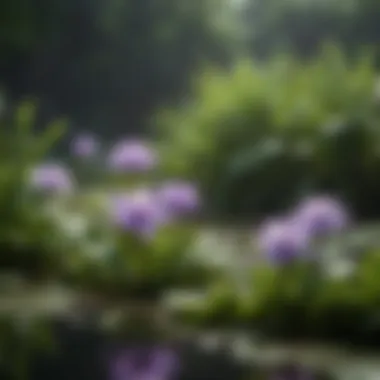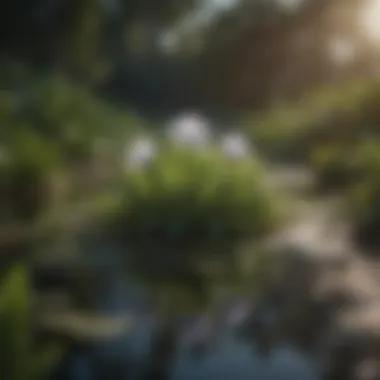Exploring Water Hyacinth: Ecological Insights and Management


Summary of Objectives
This article aims to provide a detailed examination of the water hyacinth as a notable pond plant. Through a careful analysis of its biological features, growth tendencies, and the implications for pond ecosystems, we seek to highlight both the advantages and challenges posed by this intriguing species.
Importance of the Research
Understanding water hyacinth is essential for ecologists, pond managers, and conservationists. Its widespread prevalence and rapid growth can both benefit and hinder aquatic environments. Addressing these elements supports effective management and promotes sustainable practices.
Intro
Water hyacinth, scientifically known as Eichhornia crassipes, is a remarkable aquatic plant that captures attention with its striking appearance and rapid growth. Originating from South America, this floating perennial has become widely recognized in various global water bodies, including ponds, lakes, and rivers. While it can greatly enhance the beauty of aquatic landscapes, the implications of its presence demand a thorough understanding.
The water hyacinth's buoyant leaves and purple flowers not only contribute to aesthetic value but also evoke interest regarding its ecological roles and challenges. These plants can create habitats for various species, serving as a refuge and a food source. However, they often exhibit aggressive growth, which can lead to significant ecological and management problems.
A closer investigation reveals the complexities surrounding water hyacinth. Its ability to adapt and thrive poses both benefits and threats to water quality and biodiversity. To navigate these challenges, proper management practices and awareness are crucial. This article synthesizes current research and offers insights into the multifaceted relationship between water hyacinth and pond ecosystems.
Preamble to Water Hyacinth
Water hyacinth is a fascinating aquatic plant with a significant role in both ecological systems and ornamental gardening. Understanding this plant’s characteristics and historical context is essential. It offers numerous benefits while also presenting various challenges that can affect pond ecosystems. This section aims to shed light on the importance of water hyacinth through detailed definitions and insights into its historical background.
Definition and Overview
Water hyacinth, scientifically known as Eichhornia crassipes, is a floating perennial plant native to the Amazon Basin. Its leaves are thick, waxy, and shiny, often arranged in a rosette formation. The plant produces beautiful lavender flowers that give it aesthetic value, making it a popular choice in ornamental ponds. Water hyacinth thrives in warm, shallow waters, thanks to its ability to grow rapidly. Each plant can generate multiple progeny in a short time, resulting in large floating mats that can cover extensive water areas.
The ecological significance of water hyacinth cannot be overstated. Besides its visual appeal, it plays an essential role in supporting aquatic life. The dense coverage can create habitats for fish and other organisms. However, the plant’s prolific growth can lead to serious issues such as reduced water flow and limited sunlight penetration, impacting other aquatic plants and animals.
Historical Context
Water hyacinth has a long and intriguing history, first introduced outside of its native habitat in the 19th century. Originally brought to the United States in 1884 for ornamental purposes, its rapid growth quickly turned into an environmental challenge. It spread to various regions, particularly in the southern states, causing significant disruption to local ecosystems.
Its introduction altered many freshwater environments, with instances in Florida demonstrating how quickly the plant can dominate a pond surface. Local authorities and environmental scientists have since put forth numerous efforts to control its spread, recognizing its potential for both beauty and ecological disruption.
"Water hyacinth represents a paradox of natural beauty and ecological threat."
Understanding the historical background of water hyacinth helps to frame its current relevance. Lessons learned from management practices are critical to balancing its desirability as a pond plant against its invasive tendencies. Recognizing the duality of water hyacinth’s nature informs ongoing discussions about sustainable management strategies.
In summary, water hyacinth is not just a pond plant; it is a pivotal player in aquatic ecosystems and an object of sustained interest due to its contrasting attributes. This section sets the stage for the following discussions on its biological characteristics and ecological roles.
Biological Characteristics of Water Hyacinth
Understanding the biological characteristics of water hyacinth is crucial, as these traits influence its behavior in ecosystems and its management. Water hyacinth, known scientifically as Eichhornia crassipes, is a perennial aquatic plant. Its features play a significant role in how it interacts with its environment and how it can be managed in aquatic gardens or natural bodies of water.
Morphological Features
Morphologically, water hyacinth possesses distinctive characteristics. The plant has thick, waxy leaves that are buoyant. The leaves are often ovate to elliptical in shape and can measure up to 30 cm long. Each leaf rests on a long petiole, which supports it above the water's surface.
These adaptations allow the plant to float, facilitating access to sunlight essential for photosynthesis. The root system develops freely in water, providing stability and improving nutrient uptake. Leaves are arranged in rosettes, which helps minimize wind damage. Moreover, the plant produces vibrant lavender flowers. These flowers are not only visually appealing but are also critical for reproduction.
Reproductive Strategies
Water hyacinth has efficient reproductive strategies that contribute to its rapid proliferation. It mainly reproduces vegetatively through stolons. This means that new plants emerge from the existing ones, creating thick mats on water surfaces. In favorable conditions, a single plant can lead to the formation of hundreds of new plants in a short time.
Additionally, water hyacinth can reproduce sexually by producing seed pods, containing the seeds. The flowers are hermaphroditic, allowing for self-pollination or cross-pollination with other plants. Seeds can remain viable for years, allowing the species to spread rapidly when conditions become favorable.
Photosynthesis and Growth


Water hyacinth exhibits an efficient photosynthesis process that underpins its vigorous growth. The plant primarily employs C3 photosynthetic pathways, utilizing sunlight to convert carbon dioxide and water into sugars and oxygen. High growth rates can occur under optimal conditions, with some reports indicating daily increases in biomass of up to 50 grams per square meter.
Environmental factors like light availability, nutrient levels, and temperature greatly influence growth rates. The plant thrives in nutrient-rich waters often found in ponds, lakes, and slow-moving streams.
"The rapid growth of water hyacinth can significantly alter pond ecosystems, impacting water quality and biodiversity."
Ecological Role in Pond Ecosystems
Understanding the ecological role of water hyacinth in pond ecosystems is crucial for evaluating both its benefits and potential challenges. Water hyacinth, while often regarded as an invasive species, plays a significant role in maintaining ecological balance. It impacts the physical, chemical, and biological facets of water bodies where it proliferates.
Impact on Biodiversity
Water hyacinth can positively and negatively affect biodiversity. On the one hand, it provides shelter and nourishment for various organisms. Fish species, amphibians, and invertebrates often find refuge among its dense growth. The plant creates a microhabitat where smaller creatures can thrive, contributing to the pond's overall biomass.
However, if uncontrolled, water hyacinth can also suppress native plant species. They compete for light and nutrients, which can lead to diminished plant diversity. This suppression can create a monoculture that ultimately reduces the resilience of the ecosystem. Preserving a balance between water hyacinth growth and native species is key to maintaining biodiversity in aquatic environments.
Water Filtration and Quality
Water hyacinth has notable benefits for water quality through its ability to filter pollutants. The roots absorb excess nutrients such as nitrogen and phosphorus, which are often present in agricultural runoff and sewage discharge. By reducing these nutrient levels, water hyacinth can help mitigate issues like algae blooms, which are harmful to aquatic life.
Moreover, the dense mat of water hyacinth slows down water movement. This can facilitate sedimentation and promote effective natural filtration processes. The increased turbidity from suspended particles can also decrease, leading to clearer water. Clear water is essential for various aquatic organisms, which rely on light penetration for photosynthesis and growth.
Habitat Provisioning
Water hyacinth serves as an important habitat provider within pond ecosystems. Its structure offers numerous niches for various aquatic organisms. Eggs and larvae of fish are often found in the safety of the roots, while birds may use the plant as perches and nesting sites.
Additionally, the floating mats can regulate water temperatures by providing shade, which is beneficial for temperature-sensitive species. This micro-environment promotes biodiversity and stability within the pond ecosystem.
Water hyacinth also aids in creating dynamic habitats. The presence of various animal and plant species offers resilience, making the ecosystem better equipped to withstand environmental changes. Overall, the role of water hyacinth in habitat provisioning should not be overlooked, as it contributes significantly to the overall functionality of aquatic ecosystems.
Conclusion: Water hyacinth's presence in pond ecosystems is complex. While it harbors certain advantages, careful management is essential to balance its role and mitigate challenges associated with its invasive properties.
For more information on aquatic plants and their roles, you can visit Wikipedia or Britannica.
Benefits of Water Hyacinth in Aquatic Gardens
Water hyacinth offers multiple benefits when introduced in aquatic gardens. Its presence can enhance both the aesthetic and functional qualities of the ecosystem. As gardeners seek to create lush, vibrant environments, water hyacinth can undoubtedly play an integral role. This section delves into three primary aspects: aesthetic appeal, erosion control, and fisheries support. Each of these elements shows how beneficial water hyacinth can be, while ensuring the health of pond ecosystems.
Aesthetic Appeal
One of the first noticeable advantages of water hyacinth is its aesthetic appeal. The plant has distinct green, broad leaves and striking purple flowers that can add beauty to any pond. When planted in clusters, the visual impact increases significantly, transforming a somewhat mundane aquatic space into a vibrant oasis.
In addition to the visual attraction, water hyacinth contributes to the layering of a pond. Its floating leaves create shaded areas that can enhance the diversity of life forms in the water. Such variations can make aquatic gardens not just appealing to humans but also more welcoming for various wildlife species. Gardeners have reported that the presence of water hyacinth attracts birds, butterflies, and other pollinators, enriching the whole environment.
Erosion Control
Another substantial benefit of water hyacinth lies in its erosion control abilities. The expansive root systems help stabilize the soil around pond edges. This is particularly beneficial in areas prone to soil erosion. As the plant proliferates, it binds the soil more effectively, reducing sediment runoff into the water. This natural process can help maintain water quality, leading to healthier aquatic ecosystems.
Moreover, the dense growth of water hyacinth can slow down water movement. This characteristic allows sediments to settle instead of being swept away. In this way, the plant acts as a natural buffer, protecting shorelines and contributing to the overall stability of aquatic habitats.
Fisheries Support
Lastly, water hyacinth plays a significant role in supporting fisheries. The plant provides critical habitat for various fish species. Its roots can serve as spawning grounds, while the water above offers shelter from predators. The dense mat of vegetation provides food and shelter, making it an essential component for developing aquatic life.
In areas where fishing is a vital part of the local economy, water hyacinth can enhance fish populations directly. By increasing habitat complexity and offering more foraging opportunities, it supports varied life stages of fish. As a result, the presence of water hyacinth can lead to better yields for local fisheries, creating sustainable economic benefits in the long run.


Water hyacinth serves various ecological roles while enriching plants and animal life in and near aquatic gardens. Its combination of beauty, erosion control, and support for fisheries highlights its importance as an aquatic plant.
Challenges Associated with Water Hyacinth
Water hyacinth, while admired for its beauty and ecological benefits, presents several challenges that warrant thorough examination. Understanding these challenges is crucial for effective management and for maximizing the benefits this plant can offer. The invasive nature of water hyacinth often leads it to dominate aquatic environments, impacting biodiversity and causing complications in water systems. This section focuses on the invasive properties, the impact on native species, and the effects on water flow and recreational activities.
Invasive Properties
Water hyacinth possesses remarkable adaptability and resilience, allowing it to spread rapidly in suitable conditions. The plant can double its biomass in as little as two weeks under optimal environmental factors, including warm temperatures and nutrient-rich waters. This unchecked growth can lead to dense mats on the water surface, reducing light penetration and causing significant alterations to aquatic ecosystems. The invasive properties not only disrupt the balance within these systems but also pose challenges to local agriculture and water management efforts.
The rapid proliferation of water hyacinth can choke waterways, affecting both natural and man-made water bodies. When agricultural or urban areas rely on these water systems, the presence of water hyacinth can hinder access and usability, creating practical challenges for farmers and ecologists alike. It’s essential to monitor and control its growth to prevent significant ecological and economic disruptions.
Impact on Native Species
The domination of water hyacinth poses serious threats to indigenous aquatic species. By covering the water surface, it deprives native plants of sunlight, leading to their decline. This not only reduces biodiversity but also alters the habitat for fish and other wildlife that depend on specific plant species for breeding and shelter. As some of these native species diminish, the integrity of the entire ecosystem is compromised.
In addition, invasive species introductions amplify competition for resources like nutrients and space. Native species may not compete effectively against the aggressive growth of water hyacinth, leading to potential extinction or significant population reductions. Conservation efforts must strategically address these dynamics to ensure the protection of vulnerable native species in affected areas.
Effects on Water Flow and Recreation
Another significant challenge posed by water hyacinth is its effect on water flow. Dense mats can obstruct natural waterways, which interferes with recreational activities such as boating, fishing, and swimming. This obstruction can also lead to increased flooding during heavy rainfall, as water flow is constrained, potentially causing property damage in nearby areas.
Moreover, recreational facilities that depend on clear water bodies may suffer economically when water hyacinth abundance decreases their attractiveness and usability. Effective management practices need to address these issues, ensuring that water hyacinth does not decrease water quality and user experience in recreational waterways.
The challenges associated with water hyacinth illustrate the necessity for effective and adaptive management strategies. Without proper intervention, these challenges may escalate to a level where the ecological balance is significantly affected.
Understanding the invasive tendencies of water hyacinth, its impact on native species, and the broader effects on water flow and recreation equips stakeholders with the knowledge necessary to address these challenges proactively. By managing these issues, we can protect aquatic ecosystems while still harnessing some of the benefits that water hyacinth can provide.
Management Practices for Water Hyacinth
Effective management of water hyacinth is crucial due to its rapid growth and potential negative impact on aquatic ecosystems. Understanding various management practices can help maintain balance in pond environments. Without proper control, water hyacinth can outcompete native plants, clog waterways, and disrupt the natural habitat. Researchers and practitioners must prioritize sustainable and innovative strategies to manage this species, maintaining biodiversity and ensuring water quality.
Mechanical Control Methods
Mechanical control involves physical removal of water hyacinth from ponds. This method requires equipment such as boats, rakes, or even specialized harvesters. Regular removal is important to prevent regrowth and spread.
- Harvesting: Regular harvesting can help in reducing the biomass of water hyacinth. Timing is vital; it is best to remove plants before they flower, which helps to minimize seed dispersal.
- Manual Removal: In smaller ponds, manual removal can be effective. This is labor-intensive but ensures that roots are pulled out, preventing regrowth.
- Mowing: Cutting the plants can temporarily reduce biomass. However, without removal of the cuttings, it can lead to decomposing material that may decrease water quality due to oxygen depletion.
The method chosen depends on the specific pond characteristics, resource availability, and scale of the infestation.
Biological Control Approaches
Biological control refers to the use of natural enemies or competition to suppress water hyacinth populations. Several organisms can help manage this plant effectively:
- Insects: Certain insects like the Neochetina eichhorniae and Neochetina bruchi target water hyacinth specifically, feeding on its leaves and roots. Introducing these insects into the ecosystem must be done with caution to avoid unintentional damage to native species.
- Pathogens: Fungal pathogens like Fusarium species can also help control water hyacinth. These pathogens can infect the plant and reduce its biomass, though this method requires careful study.
Using biological control can be environmentally friendly, but it requires monitoring to assess impact on other species in the ecosystem.
Chemical Control Options
Chemical control includes the application of herbicides to manage water hyacinth effectively. This option should be seen as a last resort, considering its potential environmental effects:
- Herbicides: Glyphosate and diquat are common herbicides used against water hyacinth. They can provide quick results but often require multiple treatments.
- Glyphosate: Typically used as a non-selective herbicide, it must be applied carefully to avoid affecting non-target plants.
- Diquat: This herbicide acts quickly, killing foliage almost instantly; however, it may need reapplication based on water hyacinth's growth rate.


Chemical control methods can pose risks to aquatic life and the surrounding ecosystem. Careful planning and assessment are necessary before applying any chemicals.
The successful management of water hyacinth requires a balanced approach, combining mechanical, biological, and chemical methods. It is important to tailor these practices based on the specific ecosystem to ensure that management efforts support overall plant biodiversity and water quality.
Cultivation and Propagation Techniques
Cultivation and propagation techniques of water hyacinth are critical for both beginners and seasoned aquarists. Understanding how to grow and spread this plant effectively can lead to lush, vibrant aquatic gardens. Water hyacinth thrives under certain conditions, which makes knowing these aspects essential in maintaining its vitality.
Optimal Growing Conditions
Water hyacinth prefers warm climates. It thrives best in temperatures ranging from 22°C to 30°C. The plant needs to be submerged in water but requires exposure to sunlight for at least six hours daily. The pH balance of the water should be between 6.0 and 7.5, promoting optimal growth. Moreover, water hyacinth flourishes in nutrient-rich waters. Therefore, incorporating fertilizers can be beneficial but must be done cautiously to prevent over-fertilization, which may jeopardize water quality.
Factors such as water flow should also be monitored. Stagnant waters can lead to unhealthy growth and may promote pests. Ideally, a moderate flow can help distribute nutrients and oxygen.
Propagation Methods
Water hyacinth is known for its ability to reproduce rapidly, which is one reason it can become invasive. However, this characteristic can be exploited for cultivation. The primary method of propagation is vegetative, where new plants sprout from the roots of the parent plant. This method is greatly effective due to the rapid growth rate of water hyacinth, often doubling in biomass in just two weeks during the growing season.
Here are some methods to consider:
- Division: Physically separate the daughter plants from the mother plant. This should ideally be done when the water hyacinth is actively growing.
- Offsets: Identifying and detaching offsets that grow from the water hyacinth’s base can increase overall plant numbers.
A very important aspect of propagation is maintaining genetic diversity. While vegetative propagation is efficient, introducing plants from different locations can improve genetic variation. This promotes resilience to diseases and helps in better adaptation to environmental changes.
"Sustainable propagation ensures the longevity of water hyacinth in aquatic ecosystems, making it a valuable asset in both aesthetics and ecology."
The careful application of these cultivation techniques can ensure a beautiful and manageable aquatic environment. Always remain vigilant about the potential for uncontrolled growth, as it can lead to ecological issues.
Recent Research and Advances
Research on water hyacinth has significantly expanded in the past few years. This plant, known for its rapid growth and adaptability, has beckoned the attention of various researchers. They aim to uncover innovative solutions and methods that enhance the utility of water hyacinth, especially regarding environmental sustainability, waste management, and its role in aquatic ecosystems.
Innovative Uses of Water Hyacinth
One of the most promising areas of research involves the novel applications for water hyacinth. Here are some key innovative uses:
- Biomaterials Production: Recent studies have explored the potential of water hyacinth fibers as a raw material for eco-friendly products. Researchers are investigating how to convert these fibers into biodegradable textiles and packing materials. This could address environmental concerns related to plastic pollution.
- Wastewater Treatment: Water hyacinth demonstrates a strong ability to absorb pollutants and excess nutrients from water bodies. This property has led to studies focusing on its use in constructed wetlands and other forms of natural wastewater treatment. With proper management, water hyacinth can play a vital role in improving water quality by reducing nitrogen and phosphorus levels in eutrophied water bodies.
- Carbon Sequestration: Some researchers are examining the role of water hyacinth in capturing carbon dioxide. As the plant grows rapidly, it may help mitigate climate change by sequestering carbon effectively, thus contributing positively to greenhouse gas reduction efforts.
Genetic Studies on Water Hyacinth
Recent genetic studies are shedding light on the species’ adaptability and resilience. Understanding the genetic makeup can lead to several benefits:
- Genetic Diversity Assessment: Researchers are conducting genetic analyses to determine the diversity within water hyacinth populations. This helps in understanding which traits allow this plant to thrive in various environments, paving the way for better management practices and control measures.
- Biotechnological Applications: Advances in genetic engineering have opened doors for modifying water hyacinth to enhance its beneficial properties. For instance, scientists are working on developing strains that can absorb higher levels of heavy metals, thus providing a potential solution for contaminated waters.
- Understanding Invasiveness: Genetic studies can also contribute to understanding the invasive nature of water hyacinth. By identifying the genes responsible for rapid growth and spread, researchers aim to develop targeted management strategies to control its population in non-native environments.
"The continuous exploration of water hyacinth’s genetic profile reveals pathways for its sustainable use while managing its ecological impact."
End and Future Directions
The exploration of water hyacinth highlights its dual nature as both an attractive pond plant and a potential ecological challenge. In the earlier sections of this article, we analyzed its biological characteristics, ecological impact, and management practices. In this conclusion, we summarize key insights and consider future directions for sustainable management of water hyacinth.
Summary of Water Hyacinth's Role
Water hyacinth serves a significant role in aquatic ecosystems. Its ability to filter pollutants and provide habitat for various aquatic organisms enhances biodiversity. The plant's striking appearance makes it desirable in ornamental gardening, contributing to the aesthetic appeal of ponds and water gardens. However, it can rapidly dominate water surfaces, leading to negative consequences such as impaired water flow and reduced oxygen levels.
"Water hyacinth demonstrates both ecological benefits and challenges, emphasizing the need for careful management."
Understanding this duality is crucial. It becomes evident that while water hyacinth contributes positively to water quality and biodiversity, it can also become a problematic invasive species if not managed appropriately. Such insights point to the necessity for ongoing evaluation of this species in various ecosystems.
Potential for Sustainable Management
The future of water hyacinth management lies in the development of sustainable practices that balance its benefits and challenges. Current management strategies include mechanical removal, biological control through natural predators, and chemical methods. Each of these approaches has its advantages and disadvantages, requiring careful consideration.
- Integrating multiple management strategies: Emphasizing a holistic approach can enhance effectiveness. For instance, combining mechanical control with biological methods may reduce the regrowth rate of water hyacinth while minimizing environmental impact.
- Innovating cultivation: Research into propagating water hyacinth for beneficial uses—such as bioenergy production or water purification—can also present new opportunities. These uses may transform a nuisance into a resource, promoting sustainable practices.
- Education and community involvement: Local communities can play a pivotal role in managing water hyacinth. Raising awareness about its benefits and potential hazards can empower individuals to participate in management efforts.















